
These blog posts report on work-in-progress within the DfG course! The posts are written by groups dealing with the brief on ‘Pilot project for Personal Budgeting Model’, provided by the Ministry of Social Affairs, Finnish Institute for Health and Welfare (THL), and the Social Insurance Institution of Finland (Kela) in collaboration with the ORSI project.
—
Group 1B: Helena Eharand from International Design Business Management (BIZ) program, Lucia Llerena from International Design Business Management (ARTS) program, Matleena Inget from the Creative Sustainability (BIZ) program, and Ruta Jumite from Creative Sustainability (ARTS) program.
Active participation – A secret to well-being and functioning personal budgeting model
“The disability services are rather seen as a mandatory handout, and people with disabilities aren’t seen as active citizens who could design better systems for themselves. As a result, the current services are designed without involving enough.”
– Insight 03 from the mid-term presentation of 1B.
After the mid-term presentation, receiving feedback from the stakeholders, and careful consideration, our team decided to focus mainly on thinking about how we could involve people with disabilities in relevant institutions. By this, we would ensure that the service system and Personal Budgeting Model would be designed and created by the end-users themselves.

Design drivers for the project: involvement, opportunities for active participation, and empowerment
We started to move towards the intervention ideation by determining design drivers for the project. Design drivers describe the core principles of problem-solving, the reasons why the problem-solving should take place, and the goals of the project (Heinonen 2021). In other words, design drivers help to vision the outcome of the project and to set the boundaries within which the ideation takes place.
Based on the insights of the research phase, we decided that our vision is to redefine the paradigm of disabilities and transform society so there is no division between people with disabilities and the rest of society. We understand that this kind of paradigm shift requires time and deep level changes but we want to take steps towards it with the help of this project. Therefore, our goals for the design process are following:
- Involve people with disabilities in designing processes, power structures, and relevant institutions as active participants and decision-makers.
- Provide people with disabilities tools to act, participate and raise their opinions.
- Design a concept for the government to empower people with disabilities and inform policy change.
We hope that by having these principles in our minds we can design solutions that are simple, support ecological and societal sustainability and activate people with different kinds of disabilities and backgrounds to create a future together. The determination of design drivers was beneficial since it made sure that we have a shared understanding of what we want to achieve during the rest of the course.
Imagining future scenarios with the help of speculative design tools
The spring weather allowed us to have an outdoor brainstorming workshop during week 7. In the workshop, we focused on visioning the future scenarios of work, employment, and participation with the help of speculative design tools. The speculative design aims to provide tools to imagine alternative worlds and scenarios about how our world could exist in the future (Dunne & Raby 2013). With the help of these tools, we aimed to ensure that we didn’t limit our thinking to the current world order.
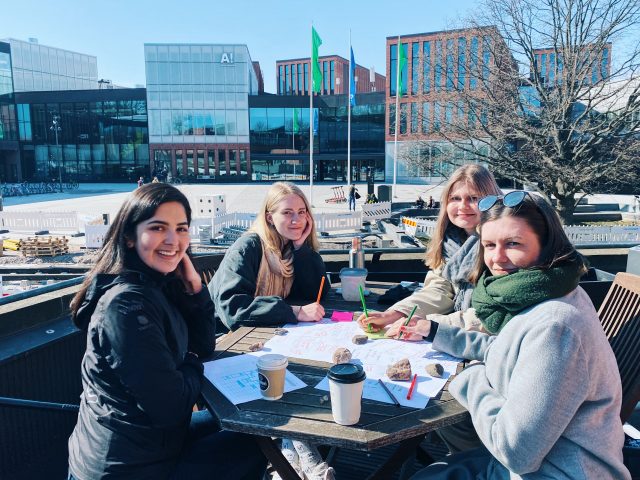
We started by determining the utopia which, for us, is a world where there is no division between so-called normal people and people with disabilities. After that, we discussed the steps that should be taken to achieve this utopia. The steps include for example strategy to involve and employ people with disabilities in relevant institutions as well as rethinking the definition of the work and how the value from it is measured. We agreed that the development and design process of a personal budgeting model would be a suitable starting point for taking steps towards this utopia.
Next steps on a journey of building wellbeing through employment and participation
During the past couple of weeks, we understood that we aim to create well-being for people with disabilities and society by creating opportunities for active involvement and participation for people with disabilities. In practice, this could mean for example developing solutions that increase the employment of people with disabilities. After careful consideration of the current state of the situation, we decided that we will focus on creating a solution which as a governmental action will be either partnering or planning. According to Policy Lab (2020), partnering means establishing a formal partnership on an issue of importance to parties and planning means setting strategy or making plans.
Thanks to the workshop and the tutoring sessions, we realized that we need to start narrowing down the links and connections of the future work and personal budgeting model. However, we think that this and the future visioning should be made by the people with disabilities so that the solution of the project would meet the actual needs. Therefore, we are having a workshop with people with disabilities next week where we imagine together what would be the ideal world in terms of employment and participation and how personal budgeting model-related solutions could guide us towards that.
Further reading:
Dunne, A., & Raby, F. (2013). Speculative Everything: Design, Fiction, and Social Dreaming. MIT Press.
Resources:
Dunne, A., & Raby, F. (2013). Speculative Everything: Design, Fiction, and Social Dreaming. MIT Press.
Heinonen, T. (2021). From problem space to opportunity space [Lecture video]. in course Design for Government 2021.
Policy Lab. (2020). Introducing a “Government as a System” toolkit. Www.Gov.Uk. https://openpolicy.blog.gov.uk/2020/03/06/introducing-a-government-as-a-system-toolkit/
—
Group 1C: Eve Nieminen and Diana Becares Mas from the Creative Sustainability program, Esko-Matti Helin from Collaborative and Industrial Design program, and Faye from Human Computer Interaction Design program.
How to reduce the barrier of communication – research on the mobility service for disabled people
“Clear and open communication can reduce a lot of trouble”, is main point we got from user interviews, and it coincides with our design drive.
3 design drivers:
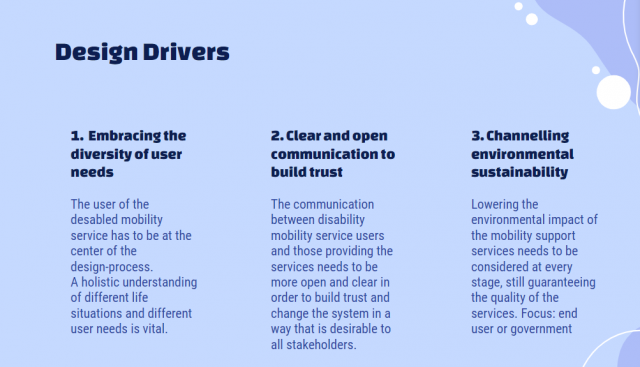
2. Clear and open communication to build trust.
3. Channeling environmental sustainability.
Although we have identified the design drivers, these driving drivers are still relatively general. In our interviews, we also found that users often suggest that we should look for solutions that will change the current system precisely. We still hope to find a novel and convenient entry point to solve the problem fundamentally. For this reason, we seek to find breakthroughs in user-related communication issues.
Intervention analysis:

From the government intervention points matrix, we picked 8 main points that we think are relevant to our project, and also divide them into closer level1 and more general level 2 in advance. The “choice architect” serves the role to change the whole system, and “collaborating” means the collaboration of each stakeholder to further improve the service. Connection layers have similar meanings to” collaborating” but on a more general level, and in the last one the consumers are corresponding to the disabled users, the supply chain is the service provided.
Communication problems:
After summarizing the opinions to generate the design drivers and also analyzing the intervention points, finally, we decided to put the main research point on the solution of communication problems. In fact, through user interviews, we have received a lot of feedback, but most of the feedback is fragmentary and involves many practical problems of the system. In order to propose a systematic design direction, we attributed part of the problems to communication problems between disabled users and authorities and service providers. We found that defective communication can explain most of the negative feedback we receive.
Communication problems can be subdivided into many types. We have also held many seminars to summarize the pain points in communication problems and found the following:
- How might we improve the communication in order to build trust and a better understanding of the (new services)?
- How to build a positive feedback channel?
- How might we communicate the advantages of using public transport to disabled user’s needs in order to make public transport be convinced to use?
Many practical problems can be attributed to these points, especially the problems that disabled people do not use public mobility services and existing systems cannot be improved.
Future plan
We have realized the importance of communication, but we still don’t know what the parties think about this topic, and we don’t know if they have any suggestions on this “communication topic“ we have summarized. So we hope to hold a workshop next week to invite people with disabilities, service providers (social workers), and others to discuss it together. We will formulate a new theme that is different from the initial user interviews, and guide participants to make more constructive and targeted speeches. Through this way, we hope to evaluate our analysis and push our project to a new level.
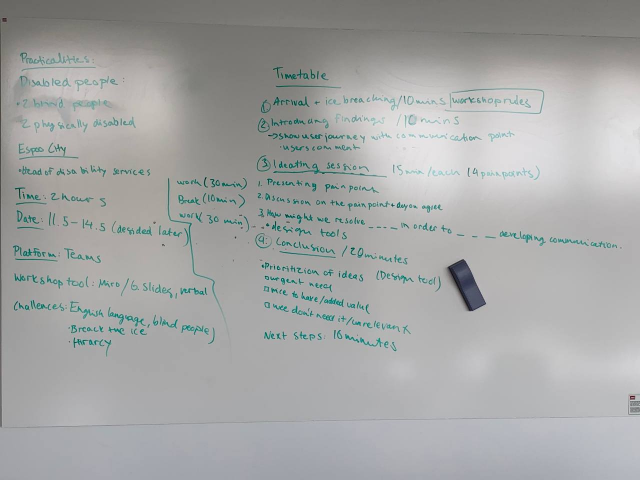
—
Group 1A: Senni Alho, Katriina Kenttamies and Naiquan Gu from the Creative Sustainability program, and Ondřej Zajíc from the Collaborative and Industrial Design program.
Finding leverage points in disability services
In our research, we found that one of the greatest challenges of current disability services is the lack of information and communication between stakeholders. People with disabilities, their caretakers, and social workers are exhausted from navigating the complicated web of services where information is scattered and hard to find and/or interpret, and very few seem to have a complete understanding of the system. We believe this issue must be addressed in order for any new model to succeed.
After our research, we formulated design drivers, prioritized the opportunities we found in the research phase using leverage points and started to think about the kinds of design interventions that could tackle them.
Design drivers
Our design drivers will act as guiding principles for our design process, which we can also use as criteria to measure the quality of our ideas. Our 4 drivers are listed below in order of priority:

Whatever our outcome is, the goal is that it increases the autonomy of people with disabilities, improves the accessibility of information about services and the application processes, contributes to improving communication between stakeholders, and further enables people with disabilities to become active members of society.
Leverage points and design interventions
Our next step was to identify leverage points in the system. These are places where an intervention/solution can create change in the whole system. In our research, we found that municipalities play a key role in disability services, as they are the places where legislation, subsidies, applications, and provisions for disability services are processed and synthesized into services delivered to the end-users. This is why we believe that the highest leverage points are located between the municipalities and other key stakeholders (Kela, social workers, service providers, and THL).
Changes on the legislative level can also have significant systemic impacts. Since THL informs the Ministry, which creates the legislation regarding disability services, we added a leverage point between them as well.
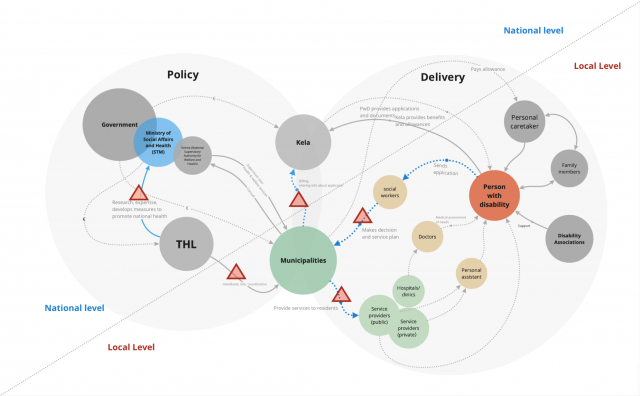
Process
We have found the various methods and steps we have done so far to be helpful, although at times it has been difficult to hold off from drifting into the ideation phase. We finally feel like we have gained a deep understanding of the system, but because our research revealed multiple problems and opportunities, we have struggled with choosing one to focus on. We felt slightly frustrated because we want to solve as many problems as possible, but we also realize it is not feasible in this time frame.
Working with leverage points and identifying types of interventions this past week required us to make a final decision about where and how we are going to intervene in the system. We eventually decided to focus on the leverage point between the municipality and the end-user, and especially on communication and the role of social workers. This also requires us to look at who informs social workers/municipalities, and how.
We have also started thinking about the types of design interventions that would be suitable targeting these leverage points using the Policy Lab design interventions taxonomy (Cooper, 2021). We found this tool to work as a helpful prompt to start thinking beyond the usual set of design tactics, but we still need to narrow these down further.
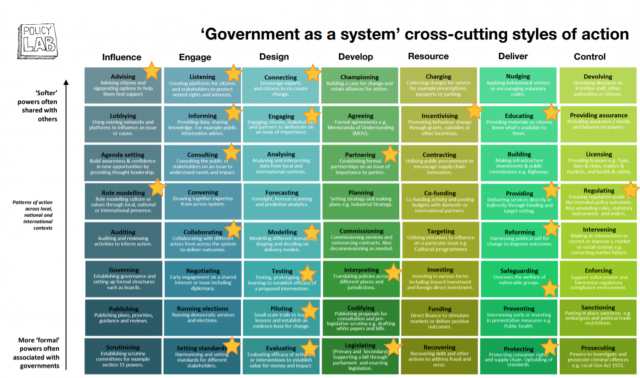
Next steps
In the following weeks, we plan to conduct co-design workshops with our stakeholders, one for ideation and one for testing/validating our concepts. We have invited end-users, municipality social workers, and THL employees to participate in the ideation workshop. The plan is to first introduce our findings and start a discussion about them, and then facilitate creative, collaborative idea-generation exercises. The testing workshop will be conducted in collaboration with groups 1B and 1C.
Our next steps are to plan the workshops and to continue working on our system map. The plan is to flesh out the details of the connections around the municipalities in order to locate more specific leverage points within them, which will help us with identifying the types of interventions suitable for us.
We believe the workshops will be very fruitful and we are looking forward to hearing what ideas our stakeholders may come up with!
References:
Cooper, A. (2021). Government as a System. Design for Government lecture. Aalto University. 19 April 2021.
—
